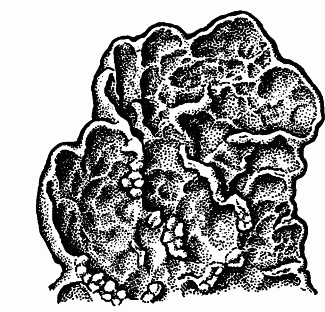Click on the image below to view an
expanded illustration for this species.

|
General:
Common Name: The Paw Lichens. Alludes to the presence of brown, paw-like apothecia on the lower surface; in all other genera the apothecia are located over the upper surface or along the lobe margins.
Small to medium or large stratified foliose lichens, corticate above and below, sorediate or isidiate or not, lobes loosely appressed to loosely attached, short to elongate, averaging to 0.5–2 (–3) cm wide, thin. Upper surface greenish, greyish or brownish, dull or shiny. Lower surface pale to dark, naked or more or less covered in dense woolly tomentum, occasionally also tuberculate, lacking rhizines. Medulla white (yellow to orange). Photobiont green and/or blue-green.
Apothecia appressed over lower surface near lobe tips, disc brown; spores 4-celled, spindle-shaped, pale brown, 8 per ascus.
Over trees, logs, mossy rocks.
Notes: Nephroma is a cosmopolitan genus of about 40 species worldwide. Nine are known from North America and all occur in B.C. Although thin-layer chromatography has been used successfully in the elucidation of some Nephroma species (see for example James and White 1987), spot tests are of little taxonomic value in this genus.
Species description:
Photobiont a dark blue-green cyanobacterium; upper surface brownish, greyish, or if greenish, then also sorediate or isidiate; ecology and distribution various AND
Lower surface naked or minutely woolly, “woolliness” not obscuring fine details of surface wrinkles; soredia present or absent AND
Thallus sorediate or, if apparently isidiate, then “isidia” densely clustered AND
Upper surface yellowish green, more or less net-ridged/reticulate; restricted to old-growth forests; rare
Reactions:
All spot tests negative.
Contents:
Nephroarctin, phenarctin, usnic acid, zeorin and an unidentified triterpenoid.
Source: Lichens of British Columbia |